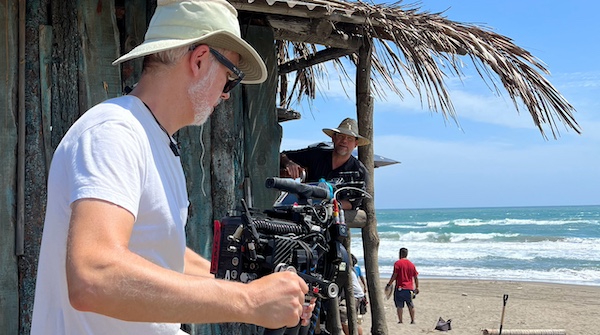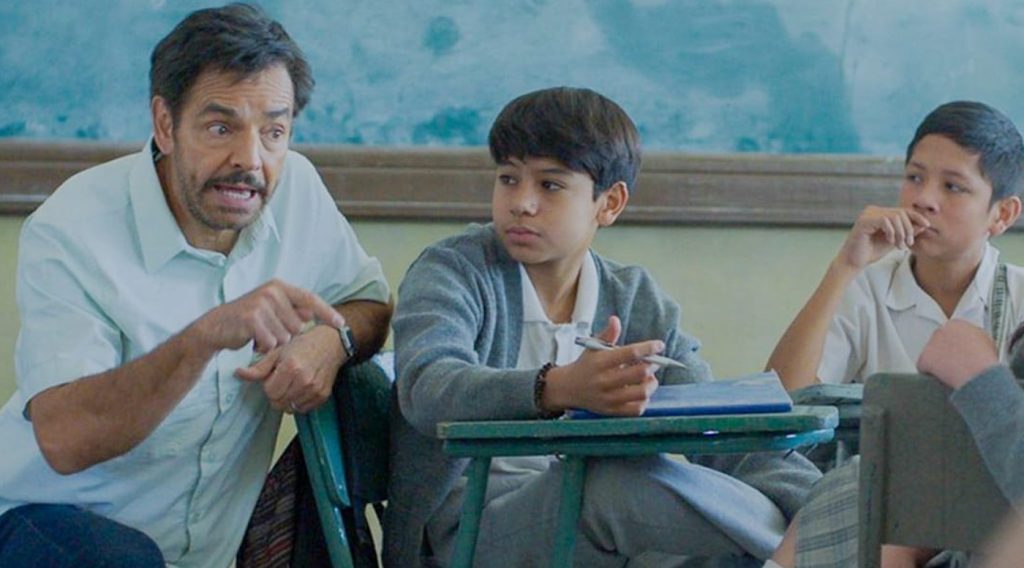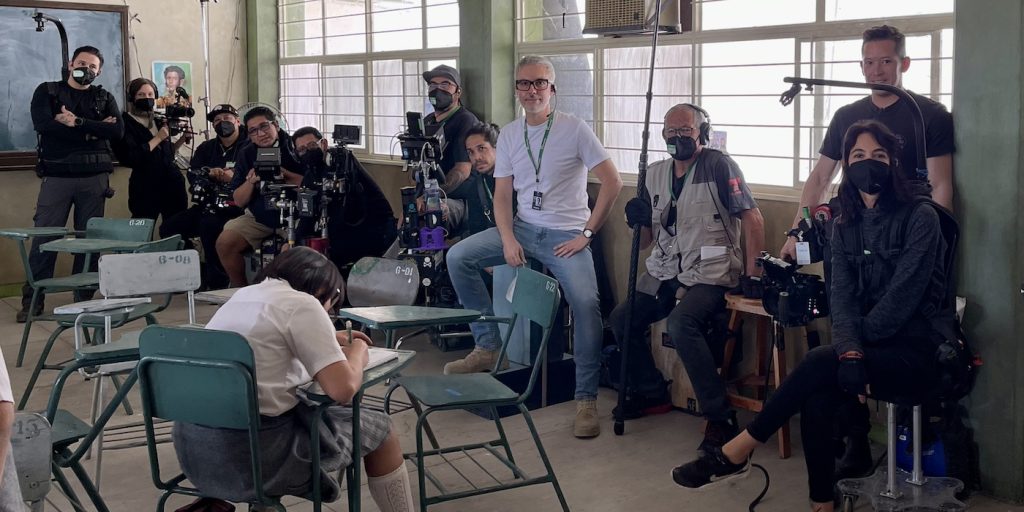“Radical” Cinematographer Mateo Londono Takes us to School in Christopher Zalla’s Moving New Film
A maverick teacher challenges the norms at an elementary school in the border town of Matamoros in northern Mexico. Such is the fact-based story that unfolds in Radical (in theaters now), led by Mexican star Eugenio Derbez (Coda, Instructions Not Included) in a film directed by Chris Zalla (Blood of My Blood).
The teacher, Sergio Juarez Correa (Derbez), aims to teach his students lessons that will help them navigate the difficult world outside the classroom, with their school situated along the Rio Grande across from Brownsville, Texas, a place where extreme violence is common thanks to the drug wars happening all around them. [The film is set in 2011, at the height of the violence.]
Crucial to the success of Radical is cinematographer Mateo Londono (The Valet, There Are No Saints), who shaped the rich visual narrative on display in Zalla’s film. Londono deployed vintage lenses and minimalistic lighting to create an authentic visual palette to bring Radical to life and integrate personal insights with Zala’s well-defined vision for the script.
“(Chris) has a fascinating way of building characters, through the use of details…and I made it part of the visual language of the film.”
For strategic planning, a shot list guided the process, focusing on blocking rather than storyboarding. This flexible approach allowed a balance between structure and spontaneity, which is particularly crucial in Zalla’s story about
“One of the most important aspects of the look of the film is that it’s spontaneous, and we did not want to kill that spontaneity, especially working with the kids. Scenes involving adult actors followed a more classic construction.”
Although the film unfolds in Matamoros on the Texas border, the actual shooting occurred in Veracruz, Mexico, where the waters of the Gulf of Mexico vary in moods — from Caribbean-like hues on some days to a more muted, brownish tone on others. A meticulous color correction process sought to unify them, ensuring a seamless portrayal of the film’s visual narrative.

“Blue symbolized possibility, while red conveyed the opposite. Those were the only colors that we gave an intentional meaning to.” Commenting on the almost muted shades of the film, he elaborated: “We tried to be very minimalistic…we intentionally avoided saturated colors. We actually tried to desaturate colors quite a bit. Not because we’re trying to make it look gritty but simply because we didn’t want it to be distracting. In this film, we tried to be as restrained as we could. We wanted the film to really be about the kids.”

The cinematographer honed in on the central theme of portraying life through the lens of the children. This deliberate choice, driven by the narrative’s focus on the trio of main characters – Paloma [Jennifer Trejo], Lupe [Mia Fernanda Solis], and Nico [Danilo Guardiola] – shaped the film’s language, with particular attention to the camera’s positioning. The majority of scenes involving the children maintained a low angle. “If you see any pictures of the behind the scenes of any of the camera operators, cameras are always by the belt, at the kids’ heights. We actually even measured our kids’ heights to have a range of where we wanted the camera to be.”

The commitment to authenticity went beyond just camera placement and included a deliberate effort to avoid staged setups. This allowed the audience to experience the scene as if they were students in the classroom, a focal point that plays a substantial role in the film’s overall duration.
Capturing Radical‘s spontaneous essence involved a collaborative effort with skilled Mexican camera operators who brought a wealth of experience to the table. Utilizing two main cameras throughout the film, with an additional third camera dedicated to classroom scenes, Londono embraced a hands-on approach with the operators. Providing basic instructions while allowing them creative freedom, the collaboration resembled a dynamic interplay.

Most of the kids had no prior acting experience and were unfamiliar with film cameras, which required a delicate approach. To mitigate any disruptions, the cameras were meticulously configured for minimal intrusion, with custom-built backpacks allowing the operators to seamlessly blend in with the kids. This strategy proved essential in fostering a natural environment, gradually easing the children into the filmmaking process.
To address the challenge of lighting the classrooms authentically, the cinematographer described a collaborative approach, emphasizing the minimal use of interior lighting. “We had lighting on both sides of the classroom, but we rarely put any lighting inside,” the cinematographer explained, highlighting a conscious effort to maintain authenticity. “A school with this budget would not randomly have their lights on all the time. We ultimately made the decision that the lights were just off all the time and that the light was coming from outside.”

The cinematographer outlined his method in the intricate dance of capturing classroom scenes. “We put the three cameras on one side of the class and lit from that side. They had a 180-degree view to shoot. When we felt we had most of the scenes from that side, we turned the cameras to the other side, switched our lighting, and shot in that direction. Most classroom scenes followed this approach.”

The cinematographer acknowledged the initial challenge of relinquishing control by discussing the departure from the classic Hollywood style. “But one of the first things I had to do on this film was let go of control and let it happen more,” Londono said.
Detailing the commitment to minimalism, Londono and his gaffer deliberated on every scene, aiming for the “minimum amount of light.” He explained: “We were minimalistic where we could be and then where we couldn’t, we made sure that nothing ever looked fake. And that even went all the way to defining our choice of lenses.” This deliberate choice steered away from a clinically clean appearance that might compromise the film’s emotional impact. “They don’t match as well between each other; distortions are a little more exaggerated. They would flare differently.”

The discussion also delved into the film’s representation of harsh realities, emphasizing the director’s vision to maintain hope despite challenging circumstances. Scenes set in seemingly bleak locations, such as a trash dump, were intentionally framed to preserve optimism. The use of the sky as a visual element played a crucial role in conveying optimism and moving away from bleakness. Specific scenes, like Paloma taking Nico to the top of the trash pile, strategically utilize the sky to symbolize possibility and maintain a hopeful tone.
Reflecting on his responsibility in Radical, Londono reflected, “As a director of photography, you’re always inclined to want to make people look their best… to show off, but I think part of your job is to not stand in the way of the story.”

At the end of our conversation, I asked Londono to use three words to describe the photography. Optimistic came rapidly as number one. After battling with how accurate “organic” would be but how cliche it sounds, “spontaneous” emerged as number two. And right after asking me what my pick was (it was “minimalistic”), he went for “restrained.” “I like restraint. And I think that it’s the hardest thing to do.”



